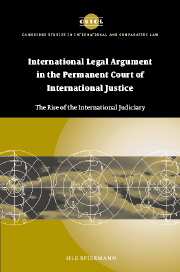 International Legal Argument in the Permanent Court of International Justice
International Legal Argument in the Permanent Court of International Justice Book contents
- Frontmatter
- Contents
- Foreword
- Acknowledgments
- Table of cases
- Table of treaties
- List of abbreviations
- Part 1 The Permanent Court of International Justice
- Part 2 International legal argument
- 2 The basis of international law
- 3 The double structure of international legal argument
- Part 3 International legal argument in the Permanent Court of International Justice
- Part 4 General conclusions
- Appendix: List of Advisory Opinions, Judgments and Orders of the Permanent Court of International Justice
- Bibliography
- Index
- CAMBRIDGE STUDIES IN INTERNATIONAL AND COMPARATIVE LAW
2 - The basis of international law
Published online by Cambridge University Press: 17 July 2009
- Frontmatter
- Contents
- Foreword
- Acknowledgments
- Table of cases
- Table of treaties
- List of abbreviations
- Part 1 The Permanent Court of International Justice
- Part 2 International legal argument
- 2 The basis of international law
- 3 The double structure of international legal argument
- Part 3 International legal argument in the Permanent Court of International Justice
- Part 4 General conclusions
- Appendix: List of Advisory Opinions, Judgments and Orders of the Permanent Court of International Justice
- Bibliography
- Index
- CAMBRIDGE STUDIES IN INTERNATIONAL AND COMPARATIVE LAW
Summary
Conceptions of the state
Back in 1899, only a few of the positions now occupied by international lawyers had been provided for. Yet 1899 was a significant year. Governments met at the First Peace Conference at The Hague to set an example of codifying international law in treaties. They reached agreement on the establishment of the first international court of a permanent character, at least nominally – the Permanent Court of Arbitration. The nineteenth century had witnessed a remarkable growth in the number of treaties, and their subject matters, many of which were also governed by national law. In the same period constitutional democracy had spread widely. While it remained a government prerogative to represent the state internationally, for example when consenting to be bound by a treaty, parliamentary bodies had become centres of national law-making processes.
In 1899, Professor Heinrich Triepel in Völkerrecht und Landesrecht addressed the topical issue of the relationship between international and national law. It is one of the few nineteenth-century books on international law that was quoted, or at least cited, throughout the twentieth century. Triepel has been seen as the main exponent of the dualist theory, according to which national and international law are separate legal systems. One consequence of this view is that acts contrary to international law may be valid under national law, and vice versa. The systems were described by Triepel as circles that perhaps touched but never overlapped.
- Type
- Chapter
- Information
- International Legal Argument in the Permanent Court of International JusticeThe Rise of the International Judiciary, pp. 37 - 78Publisher: Cambridge University PressPrint publication year: 2005
